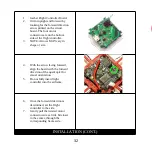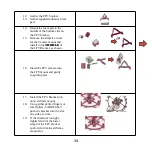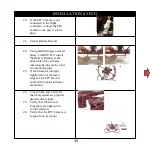
• When comfortable with low-level hovering, you can transition to hovering and flying the RV Micro at
higher altitudes of 3 to 4 ft. At these higher altitudes, you will become comfortable with the flight
characteristics of the aircraft.
• Don’t be afraid to set the RV Micro down on the ground quickly by lowering the throttle when approaching
walls or other obstacles to help prevent propeller strikes.
Once you have gained experience and confidence in hovering the RV Micro, you can attempt more
advanced maneuvers including:
• Forward Flight
•Backward Flight
•Skidding
•Takeoffs
•Pirouettes
•Spot Landings
•Landings
• Circuits (Circles)
• Figure 8s
• Flips and Rolls
Post-Flight Inspection and Maintenance Checklist
√
Cleaning
Make sure the battery is not connected before cleaning. Remove dust
and debris with a soft brush or a dry, lint-free cloth.
Motors
Replace the motor when the model will not fly steady or veers off when
doing a climb out.
Wiring
Make sure the wiring does not block moving parts. Replace damaged
wiring and loose connectors.
Fasteners
Make sure there are no loose screws, other fasteners or connectors.
Do not over-tighten metal screws in plastic parts. Tighten screws so the
parts are mated together, then turn screw only 1/8th of a turn more.
Propellers
Make sure there is no damage to the propellers or other parts that
move at high speed. Damage to these parts includes cracks, burrs,
chips or scratches. Replace damaged parts before flying.
21











































